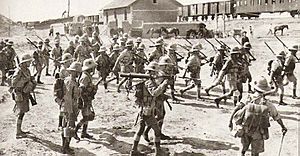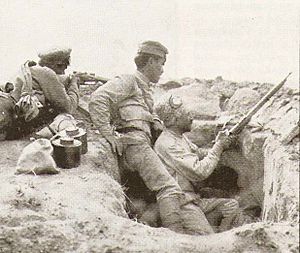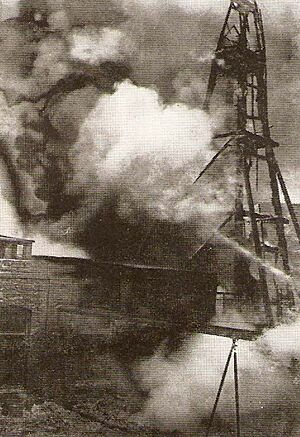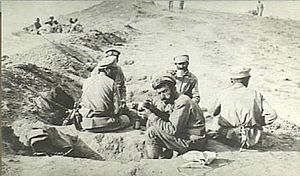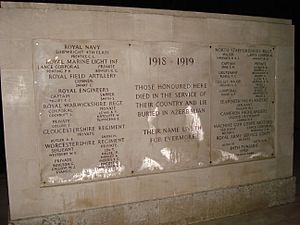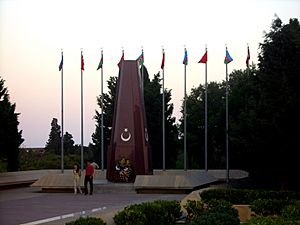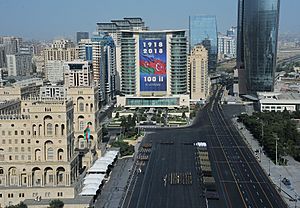Battle of Baku facts for kids
Quick facts for kids Battle of Baku |
|||||||
|---|---|---|---|---|---|---|---|
| Part of the Armenian–Azerbaijani War in the Caucasus Campaign of World War I & Southern Front of the Russian Civil War | |||||||
 Ottoman artillery bombarding the city. |
|||||||
|
|||||||
| Belligerents | |||||||
|
Until 26 July: |
|||||||
| Commanders and leaders | |||||||
| Until 26 July: From 26 July: |
|||||||
| Strength | |||||||
14,000 infantry 500 cavalry 40 guns |
20,000 infantry. 40 guns 1,000 infantry 1 artillery battery 3 machine gun section 3 armored cars 2 Martinsyde G.100 planes 6,000 |
||||||
| Casualties and losses | |||||||
| 2,000 | |||||||
The Battle of Baku was a major fight during World War I. It happened in August and September 1918. The battle was between forces from the Ottoman Empire and Azerbaijan, led by Nuri Pasha. They fought against a mix of groups. These included Bolsheviks, Armenian fighters, and later, British, Armenian, and White Russian troops. The British forces were led by Lionel Dunsterville. This battle was a key part of the Caucasus Campaign. It also marked the start of the Armenian–Azerbaijani War.
Contents
Why the Battle Happened
In 1917, the Russian Revolution caused big changes. The Russian army in the Caucasus region fell apart. A new group called the Special Transcaucasian Committee tried to take charge. This group included Armenians, Azerbaijanis, and Georgians.
New Governments Form
In November 1917, the Transcaucasian Commissariat was formed in Tbilisi. This was the first independent government in the Transcaucasia region. It was against the Bolsheviks, who had taken power in Russia. On 5 December 1917, Russia signed a ceasefire with the Ottoman Empire. Many Russian soldiers went home.
The British also got involved. They wanted to stop the Ottoman Empire from expanding. They formed a special force called the Dunsterforce. This group was led by Lionel Dunsterville. Their goal was to reach the Caucasus through Persia. They hoped to gather an army of Armenians and other groups who supported the Allies.
Land and Oil Disputes
On 3 March 1918, the Ottoman Empire signed a peace treaty with Russia. This treaty gave the Ottoman Empire some cities like Batum and Kars. Meanwhile, a peace meeting was held between the Ottomans and the Transcaucasian group.
During this time, there were serious conflicts in Baku. Many Azerbaijanis and other Muslims were killed by Bolsheviks and Armenian fighters. This event is known as the March Days. After this, Azerbaijani leaders wanted full independence. They looked to the Ottoman Empire for help.
The Ottoman Empire wanted to control the Caucasus region. They especially wanted the oil fields in Baku. This would give them valuable resources. It would also open a path to Central Asia and possibly British India.
Republics Declare Independence
On 26 May 1918, the Transcaucasian federation broke up. Georgia, Armenia, and Azerbaijan all declared their independence. Georgia made a deal with Germany for protection. The government of Azerbaijan moved to Ganja.
Germany also made a deal with Russia. Germany would get a quarter of Baku's oil. In return, Germany would try to stop the Ottoman army from attacking Azerbaijan. However, the Ottoman leader, Enver Pasha, ignored this request.
In May, a military group called the Islamic Army of the Caucasus was formed by Nuri Pasha. He was Enver Pasha's brother. This army moved into Azerbaijan. On 4 June 1918, Azerbaijan and the Ottoman Empire signed a friendship treaty. This treaty said the Ottoman Empire would help Azerbaijan if it needed military support.
Getting Ready for Battle
The Ottoman Islamic Army of the Caucasus was led by Nuri Pasha. It was based in Ganja. This army had about 14,000 Ottoman soldiers, 500 cavalry, and 40 cannons. About 30% of this army were Ottoman soldiers. The rest were Azerbaijani forces and volunteers.
The forces defending Baku were led by General Georgy Dokuchaev. Most of these troops were Armenians. They had about 6,000 soldiers and 40 cannons. Many of them were members of the Armenian Revolutionary Federation.
The British Dunsterforce was led by Major-General Lionel Dunsterville. This force had about 1,000 British soldiers. They also had artillery, machine guns, armored cars, and two airplanes. Their goal was to reach Baku through Persia.
- Opposing forces
-
Dunsterville (far left) with Dunsterforce staff.
The Battle Begins
Fighting Outside Baku
On 6 June 1918, the Baku Soviet ordered its army to attack Ganja. The Azerbaijani government asked the Ottoman Empire for military help. This was based on their treaty. The Baku Soviet troops moved towards Ganja. However, many of the soldiers that Baku needed did not arrive. This was due to orders from Joseph Stalin. This lack of troops and food hurt the Baku Soviet's chances.
From 27 June to 1 July 1918, the Ottoman Islamic Army of the Caucasus defeated the Red Army. They began moving towards Baku. By 30 July 1918, Ottoman forces were close to Baku. Dunsterville sent his British troops to Baku. They arrived on 16 August.
On 17 August 1918, the Baku forces tried to attack. They planned to close off the area to the sea. But their attack failed because they lacked artillery support.
Fighting in the City
The main part of the Battle of Baku happened from 26 August to 14 September.
On 26 August, the Ottoman army launched a big attack. They aimed for positions at the Wolf's Gate. British and Baku troops held their ground. The Ottoman forces also attacked Binagadi Hill but failed. After these attacks, more troops were sent to defend the northern heights.
From 28 to 29 August, the Ottoman forces heavily shelled the city. They attacked Binagadi Hill again. They charged up the hill but were pushed back. However, the British troops had to retreat further south.
From 29 August to 1 September, the Ottoman forces captured Binagadi Hill and Diga. Many allied units were defeated, and losses were high. Allied troops were pushed back to the hills around Baku. But the Ottoman forces also suffered heavy losses. This gave the Baku Army time to regroup.
On 1 September, Dunsterville met with the leaders of the Centrocaspian Dictatorship. He said he might have to pull out his British troops. But the leaders insisted they would fight to the end. Dunsterville decided to stay as long as there was hope.
From 1 to 13 September, the Ottoman forces did not attack. The Baku forces prepared themselves. On 12 September, an Ottoman officer deserted. He told them the main attack would happen on 14 September.
On the night of 13/14 September, the Ottoman forces began their final attacks. They almost took the important Wolf's Gate. But a counterattack stopped them. The fighting continued all day. By the night of 14 September, the remaining Baku Army and Dunsterforce troops left the city.
On 30 October, the Ottoman Empire signed a ceasefire. Ottoman forces then left Baku.
What Happened Next
About 200 British soldiers were killed, went missing, or were wounded. The Ottoman forces lost around 2,000 soldiers. After the battle, a terrible event happened. Between 10,000 and 30,000 Armenian civilians in Baku were killed. This is known as the September Days.
The capital of Azerbaijan was moved from Ganja to Baku. After the ceasefire, British troops arrived in Baku on 17 November. They took control to keep order.
No oil from Baku reached its destination before the Ottoman and German Empires signed the armistice. By 16 November, the Ottoman leaders Nuri and Mürsel Bey were out of Baku. A British general sailed into the city.
Remembering the Battle
There is a memorial in Baku for the Ottoman soldiers who died. There is also a memorial for the British soldiers.
Many Azerbaijani experts see this battle as a very important event. It shows the strong cooperation and friendship between Turkey and Azerbaijan.
100th Anniversary Celebrations
Azerbaijan and Turkey celebrated the 100th anniversary of Baku's liberation. This was on 15 September 2018. A military parade was held at Azadliq Square. The presidents of Turkey and Azerbaijan were there. The parade included soldiers from both countries. The Turkish Air Force also made a special video. A concert was held to mark the event.
Images for kids
-
A flypast of the Azerbaijani Air Force
See also
- 26 Baku Commissars
- Battle of Binagadi







